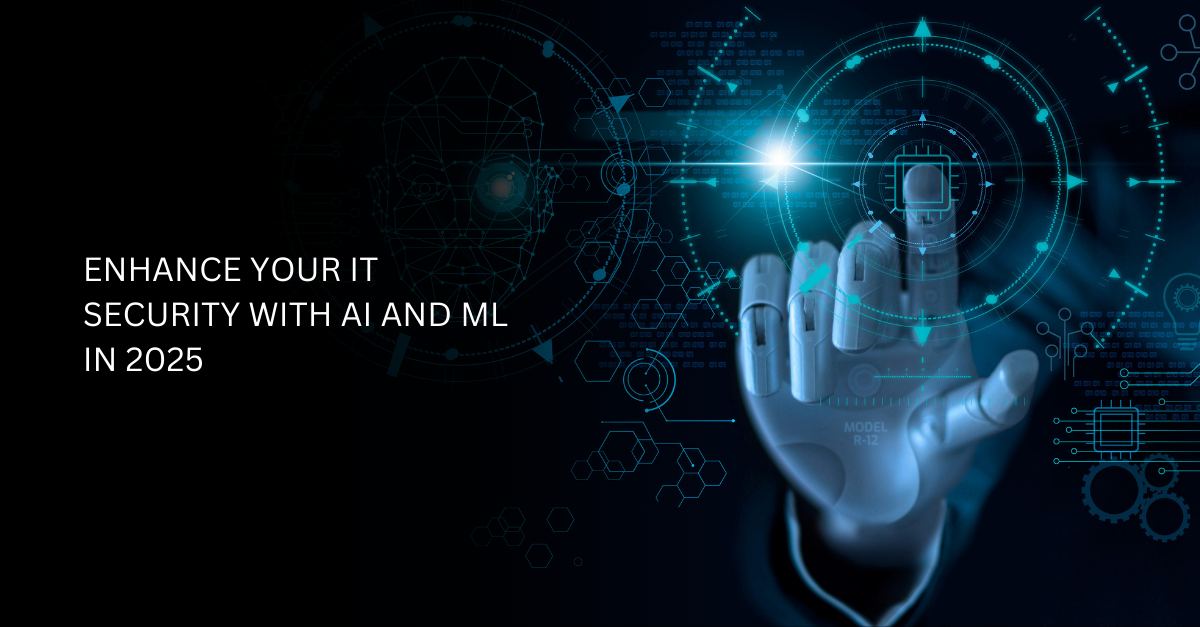Enhance your IT security with AI and ML in 2025
Cyber threats are becoming more sophisticated, and traditional security measures can no longer keep up. IT security with AI and ML are transforming how organizations defend against attacks. These technologies detect threats faster, predict risks, and automate responses. In 2025, businesses that ignore machine learning security will fall behind.
This article explains how AI-enhanced Cybersecurity works, its key benefits, challenges, and real-world use cases for AI in Cybersecurity. We’ll also discuss AI and machine learning in DevOps, AI-enabled malware and intrusion detection, and the challenges in testing machine learning systems.
Table of Contents
The growing need for AI and ML in cybersecurity
Cyberattacks are increasing in frequency and complexity. Hackers use automation, AI, and advanced evasion techniques.
Traditional security tools rely on predefined rules. They fail against zero-day exploits and polymorphic malware.
- AI in cybersecurity adapts to new threats. It learns from past attacks to predict future risks.
- ML in cybersecurity analyzes behavior patterns. It detects anomalies that rule-based systems miss.
Without these technologies, businesses face higher breach risks.
How AI and ML improve threat detection
1. AI threat detection for real-time protection
AI threat detection monitors networks 24/7. It identifies suspicious activity instantly.
Unlike signature-based tools, AI analyzes behavior. It flags unauthorized access attempts immediately.
2. Machine learning security for anomaly detection
ML in cybersecurity studies normal network behavior. It detects deviations that indicate attacks.
For example, sudden data transfers or unusual login times trigger alerts.
3. AI-enabled malware and intrusion detection
Malware constantly evolves. Traditional antivirus software struggles to keep up.
AI-enabled malware and intrusion detection use deep learning. It recognizes malicious code even if it’s never been seen before.
Key use cases for AI in cybersecurity
1. Phishing and fraud prevention
AI scans emails for phishing attempts. It analyzes language patterns and sender behavior.
AI in Cybersecurity reduces false positives, improving accuracy.
2. Automated incident response
When a breach occurs, AI acts immediately. It isolates infected systems and blocks attackers.
This reduces damage and speeds up recovery.
3. Network traffic analysis
ML in Cybersecurity monitors traffic for signs of attacks. It detects DDoS attempts and insider threats.
4. Vulnerability management
AI scans systems for weaknesses. It prioritizes patches based on risk levels.
This prevents exploits before hackers can use them.
AI and machine learning in DevOps
- Secure code development: AI analyzes code for vulnerabilities. It suggests fixes before deployment. This reduces security flaws in production.
- Continuous security monitoring: AI-enhanced Cybersecurity works in CI/CD pipelines. It scans for threats at every stage. Developers get instant feedback, improving security.
Challenges in testing machine learning systems
While AI enhances security, it has limitations.
- False positives and negatives: Challenges in testing machine learning include inaccurate alerts. Poor training data leads to mistakes. Regular model tuning is necessary.
- Adversarial attacks: Hackers manipulate AI systems. They feed misleading data to bypass detection. Defenses must evolve constantly.
- Data privacy concerns: AI needs large datasets. Ensuring compliance with GDPR and other laws is critical.
The future of AI in cybersecurity
Attackers will also use AI. Defenders must stay ahead with machine learning security.
- Predictive threat intelligence: AI will forecast attacks before they happen. It will analyze trends and hacker tactics.
- Self-learning security systems: Future tools will adapt without human input. They will improve automatically over time.
- AI-powered deception technology: Fake systems will lure hackers. AI will track their movements and gather intelligence.
AI in cybersecurity and ML in cybersecurity are no longer optional. Businesses must adopt AI-Enhanced Cybersecurity to survive in 2025. From AI threat detection to AI-enabled malware and intrusion detection, these technologies offer unmatched protection.
However, organizations must address challenges in testing machine learning to ensure reliability.
The future belongs to those who integrate AI and machine learning in DevOps and leverage use cases for AI in cybersecurity effectively.
Is your business ready? Connect with Novas Arc, and we will guide you toward a secure future.
FAQs
- How is AI used in cybersecurity?
- AI-enabled malware and intrusion detection
- Phishing and fraud prevention
- Automated incident response
- Network traffic analysis
- Vulnerability management
- What are the benefits of machine learning in IT security?
ML in cybersecurity advantages:
- Detects unknown threats using anomaly detection
- Reduces false positives with behavioral analysis
- Processes large datasets faster than humans
- Improves over time by learning from new attacks
- Enhances AI threat detection accuracy
- Can AI replace human cybersecurity professionals?
No. While AI-Enhanced Cybersecurity, humans are still needed for:
- Strategic decision-making
- Investigating complex attacks
- Fine-tuning machine learning security models
- Handling legal and ethical considerations
- What are the challenges of using AI and ML in cybersecurity?
Key challenges in testing machine learning and AI include:
- False positives/negatives due to poor training data
- Adversarial attacks that trick AI systems
- High computational resource requirements
- Privacy concerns with data collection
- Need for continuous model updates
5. How does AI-powered threat detection work?
AI threat detection follows these steps:
- Data collection – Gathers logs, network traffic, and user behavior.
- Pattern analysis – Uses ML in cybersecurity to identify normal vs. suspicious activity.
- Anomaly detection – Flags deviations (e.g., unusual logins, data exfiltration).
- Automated response – Blocks threats or alerts security teams.
- Continuous learning – Improves detection based on new attack data.
Author








